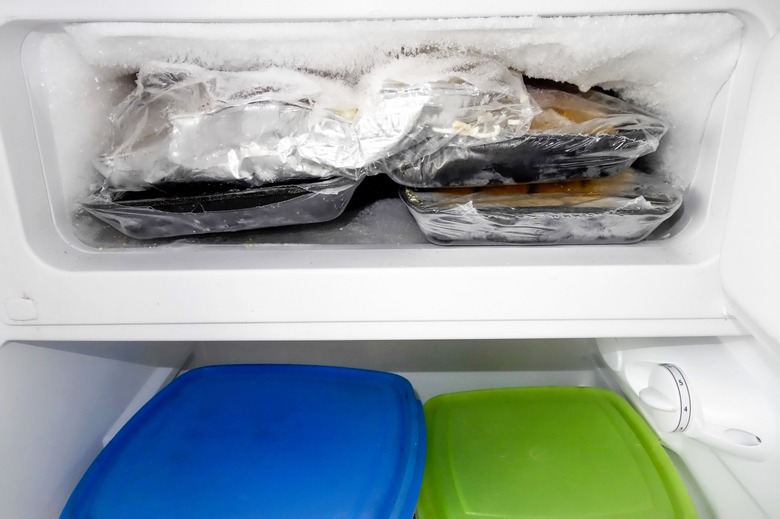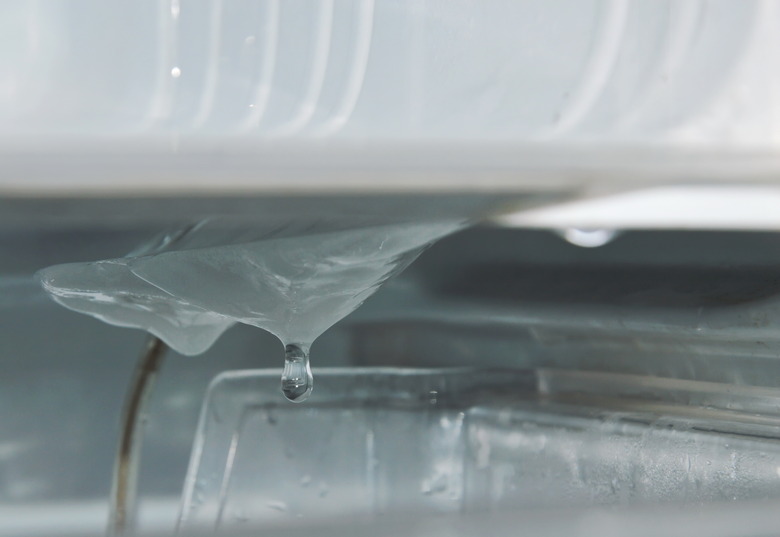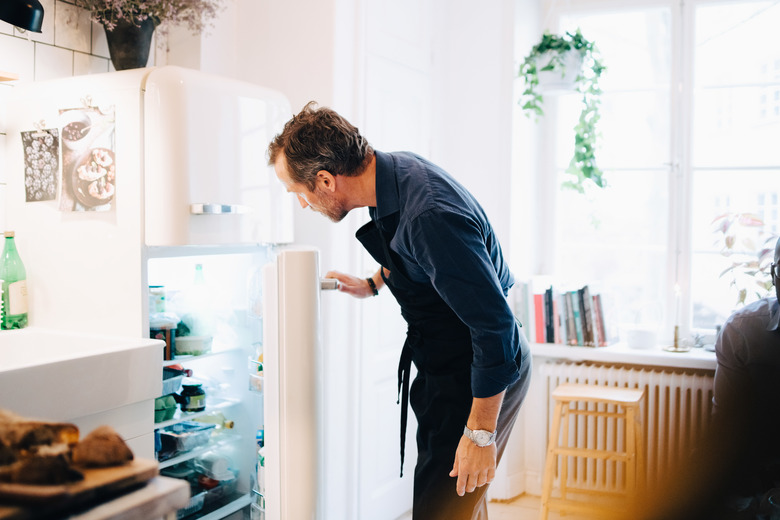How To Defrost A Freezer
If the inside of your freezer looks more like an ice cave from another world, it's time to defrost that appliance. While frost-free models defrost themselves, both fridge/freezer units and upright or chest-style deep freezers without this feature can develop an icy buildup. Defrosting any style of freezer involves unplugging the unit, finding suitable temporary cold storage for your frozen goods, and keeping an ample supply of towels on hand to clean up melting ice.
Defrosting a Chest Freezer
Defrosting a Chest Freezer
Some chest freezers aren't completely watertight and can leak water as the ice thaws, so get a tarp or sheet of plastic ready before you unplug the unit to prevent a damaged floor. Leave the freezer lid open while defrosting the unit, otherwise defrosting will take a lot longer.
- Unplug the freezer, then place all the perishable items in coolers, another freezer or even in boxes outdoors, if you are doing this work in the winter and it's below freezing outside.
- Spread the plastic tarp out on the floor near the freezer and enlist a friend's help to lift the freezer and slide the tarp underneath.
- Remove all trays or shelves from the unit, if they're not completely encrusted with ice. If they are, wait until some of the ice thaws.
- Place folded towels along the bottom of the chamber inside the freezer to help absorb water.
- Set baking pans, cookie trays or plastic storage containers inside the bottom perimeter, atop the towels, to help catch falling ice and water.
- As ice chunks fall, remove them and place them in a sink or bathtub. Empty the trays as they fill with water.
- Once the ice starts to melt, shove a plastic spatula or sturdy plastic paint scraper between the ice and the freezer to help break the ice chunks free. Do not use a metal scraping device, as this could damage the inside surfaces of the freezer.
- If the thawing process is taking too long, place a bowl of hot water inside a baking pan near the thickest ice buildup. Steam and heat will help melt the ice, while the baking pan will catch any water that drips from the ice or that spills from the hot bowl.
- After all the ice has been removed, remove the baking pans and towels. Wring the towels out over a sink and continue using the towels to sop up pooled water. Wipe the entire interior down with sponges until it's mostly dry.
- Clean the inside and outside of the freezer with a squirt or two of mild dish soap in a bucket of warm water. Stir in a tablespoon or so of baking soda or vinegar to help remove stale odors. Use a sponge to wipe down the unit with the cleaning solution. Wipe it down again with a damp clean sponge, then wipe everything dry with paper towels.
- Plug the freezer back in once it's completely dry; otherwise, remaining moisture will turn to ice crystals again.
- Place all the shelves back in the freezer. Check your frozen goods and discard anything that's extremely old. Place the items you plan to keep back in the freezer.
Tip
Some chest freezers have a drain plug on the bottom. Check your freezer manual to determine if yours has this device; if so, feel free to connect a hose to the threaded adapter on the drain, or to place a pan underneath the drain opening to catch water. Either option will help get water out of the unit faster than towels or sponges.
Defrosting Upright Freezer Units
Defrosting Upright Freezer Units
An upright freezer looks a lot like a refrigerator, but the entire appliance is designed to keep things frozen, not just cool. Defrosting an upright freezer works much the same way as a chest-style unit, except water an spill out its open door if you aren't careful.
After you've unplugged the freezer and removed its contents, place folded towels in a plastic bin on the ground in front of the freezer to catch dripping water. Another towel, rolled and placed along the inside front edge of the freezer, helps stop water from dripping to the floor. Wring out the towel frequently over the sink. As with a chest-style freezer, clean the inside of the unit once it completely thaws, then dry everything off before plugging in the freezer.
Tip
Wash removable ice cube trays, compartments and shelves while waiting for ice to thaw out of any freezer unit.
Defrosting the Freezer Compartment in a Refrigerator
Defrosting the Freezer Compartment in a Refrigerator
Defrosting the freezer portion of a refrigerator/freezer requires emptying the contents of both the freezer and the fridge, so it's best done before a grocery-shopping day, or when you plan on cleaning out the fridge anyway. As with stand-alone freezers, you'll have to unplug the appliance before defrosting.
- Place folded towels in a pan on the ground in front of the fridge's open doors once you've unplugged and emptied both the refrigerator and freezer compartments.
- Place another rolled towel along the inside front edge of the freezer compartment to help catch water trips, especially if the freezer contains a lot of ice buildup.
- Clean the shelves, trays and all removable accessories from the fridge and freezer while waiting for the ice to thaw. Wash these items in warm, soapy water, rinsing them with fresh water. Dry them with dish towels afterward, or wait for them to air dry.
- Remove chunks of ice as they begin to melt. Grab them while wearing thick work gloves to keep your hands warm. Use a plastic spatula to loosen the ice before grabbing it, if necessary. If you remove the ice as it loosens, there will be less water mess to clean up.
- Wipe down the inside and outside of the fridge and freezer once all the ice and water has been removed. Dry the inside thoroughly, replace shelves, trays and bins, then plug the unit back in and close its doors. Once the fridge cools to 40 degrees Fahrenheit and the freezer cools to 0 degrees, it's safe to place foods back inside.
Tip
Surround items that belong in the refrigerator with frozen goods in a cooler or cooler bag to help keep them cold. Even expired frozen foods you plan to throw away can be used as ice packs during the thawing process. As you're packing the items requiring refrigeration, check them for expiration dates or signs of mold. Discard anything that's no longer edible.


